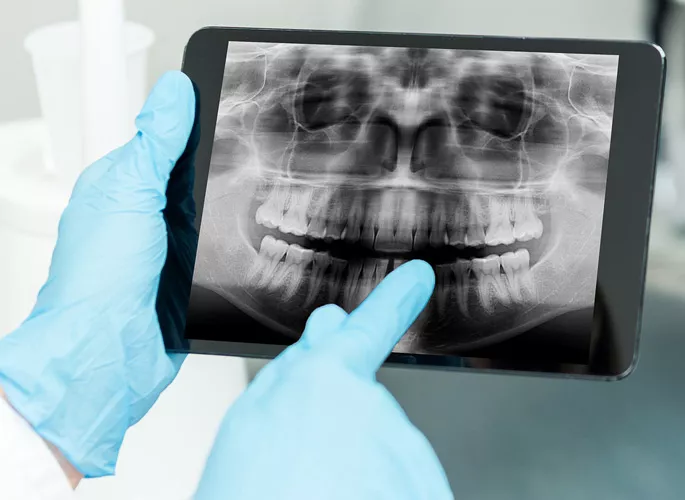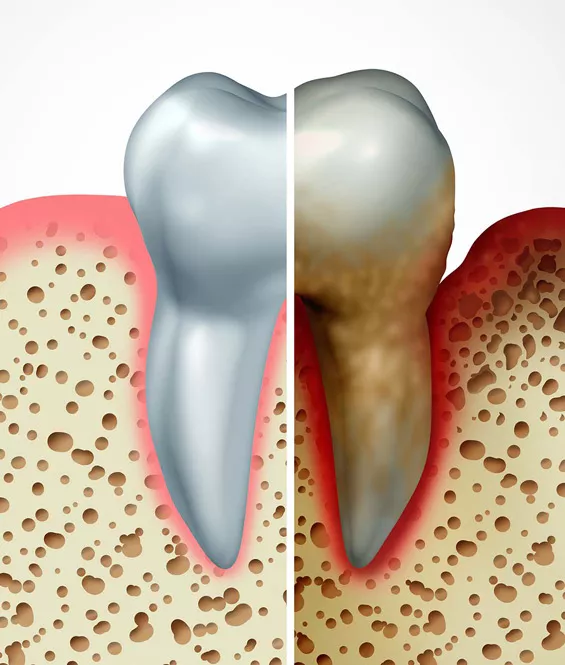Prevention and Treatment of Gum Disease
Your gums help protect your teeth from injury and infection. We provide periodontal services to help keep your gums healthy and prevent or treat gum infections and disease.

Gum Disease
Gum disease, or periodontal disease, is caused by bacteria infection of the gums. Symptoms of gum disease include bleeding or sore gums, chronic bad breath, receding gums, and loose teeth. If it isn't treated, gum disease can lead to tooth loss and has been linked to heart disease and other health conditions. It can be prevented by brushing and flossing and going for regular dental exams and cleaning.
Video: About PeriodonticsLANAP | LAPIP Treatment for Periodontal Disease
Periodontal disease is a chronic inflammation of the gums. Left untreated, patients can lose teeth and experience dental implant failure. Fortunately, patients with periodontal disease can reverse the effects with LANAP and LAPIP laser technology.
Tooth Extraction
Sometimes damaged teeth need to be extracted to prevent risk to your other teeth and surrounding tissues. We perform extractions and offer a variety of replacement options such as bridges or dental implants.
Frenectomy
Frenectomy is a procedure to remove connective tissue inside your mouth. Sometimes this tissue can be too tight and can cause discomfort and difficulty eating and speaking, so we perform a frenectomy to relieve the tension.
Scaling and Root Planing
Plaque and tartar buildup on your teeth can make your gums vulnerable to bacterial infection. Scaling and root planing are deep cleaning techniques that remove this buildup above the gumline.
Ridge/Socket Preservation
After a tooth is extracted, the socket left in your jaw may collapse. This can cause other teeth to shift positions, or the bone tissue surrounding the socket can begin to deteriorate. We prevent this from happening by filling the socket.
Ridge Augmentation
Your gums and bones form a structure known as the alveolar ridge. This ridge can deteriorate if you lose teeth and the sockets aren’t preserved. We can rebuild the ridge using bone and gum grafts.
Sinus Augmentation
Sometimes there isn’t enough bone to support a dental implant in the upper jaw. To treat this, we graft bone into the area to build up and strengthen the bone mass before placing the implant.
Bone Grafts
Damage or infection can cause the bone in your jaws to deteriorate. Bone grafts are used to build up the area and repair the damage. Once the graft is placed, it integrates into your natural bone.
Gum Grafting
gum graft, or gingival graft, is used to restore gum tissue that has been damaged. Treatment consists of grafting gum tissue from another area of your mouth over the area being treated.
Pocket Depth Reduction
Tiny pockets can form around the base of your teeth and trap food debris and bacteria. This can lead to gum infections and disease if it isn’t treated. Treatment involves surgically reducing the depth of these pockets so they no longer trap debris.
Flap Procedures
A flap procedure is used any time we need to treat the areas beneath your gums or around the roots of your teeth. The procedure involves surgically opening a tiny flap in your gums. Once we finish treatment, we close the flap with sutures.
Crown Lengthening
Sometimes we need to lengthen the crown of one or more teeth for cosmetic purposes or to prepare the tooth for restoration with a crown. To do this, we remove gum tissue from around the base of the tooth to expose more of the tooth and make the crown “longer.”
Video: Scaling
Frequently Asked Questions
How is gum disease linked to heart disease?
Research shows that gum disease can increase your risk of developing heart disease. The link isn’t completely understood. Scientists believe that untreated gum disease can increase the level of inflammation in your body, which can increase the risk of developing inflammatory diseases such as heart disease. More research is needed to completely understand this link, however.
Is there a link between gum disease and diabetes?
Research suggests that there’s a two-way link between gum disease and diabetes. Diabetes can increase the risk of developing gum disease. At the same time, good dental and periodontal hygiene may have a positive effect on blood sugar levels.
What’s the difference between plaque and tartar?
Plaque is a colorless biofilm that forms on the surface of your teeth. Bacteria can live in plaque and secrete acids that damage your teeth and irritate your gums, which can lead to tooth decay and gum infections. If the plaque isn’t removed, it hardens into tartar. Tartar is extremely hard and can’t be removed with a toothbrush. It can only be removed by a dental professional using special tools.







